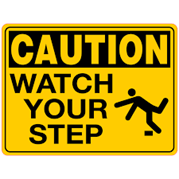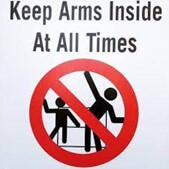Pictograms/Risk Warnings: Are they sufficient?
-
Étude de marché 12 septembre 2022 12 septembre 2022
-
Asie-Pacifique
-
Assurance et réassurance
The use of pictograms to warn entrants of common or obvious risks can help to reduce liability and risk of injury, thereby reducing the number of claims made against a business or a whole industry. In addition, by warning entrants of these risks, operators are limiting their liability, and placing the onus on the entrant to take reasonable steps for their own safety, which in turn, reinforces the purpose of tort law reform that each person take personal responsibility for their own actions.
Introduction
A pictogram is a simple illustration or set of illustrations which are used to communicate rules or communicate risk to entrants to an amusement ride, amusement park or other leisure activity.
Examples of pictograms are set out below:



Pictograms are an easy, quick and cost effective way of reducing liability and the financial risk from injury to participants in leisure activities. Pictograms can decrease the instances of misuse or inappropriate use of equipment, again leading to less injuries, less claims and prospectively leading to reduce risk transfer or insurance expense for operators.
Leisure activities all present a risk of injury, this risk is higher to anyone not complying to safety warnings, or operator instructions. Some attractions may also pose an increased risk of injury to participants with pre-existing medical conditions, such as heart conditions, abnormal blood pressure or conditions such as epilepsy.
Operators have a duty of care to take reasonable precautions to prevent injuries to participants, and this duty of care extends to notifying entrants about the possible dangers and risks associated with the attraction, park or activity. Experience suggests that the risk of injury goes beyond the amusement activities themselves, and can arise from weather conditions, pools, heights and even native animals (there is a notorious case in the USA where a young boy was killed by an alligator at a Disney resort).

How does a business engaged in the provision of amusement and leisure services limit its liability for injuries arising from accidental or intentional misuse of the attraction, or the risk of injury from a pre-existing medical condition?
Liability waivers have been found to effectively limit the liability of amusement and leisure operators if it can be established that the liability waiver formed part of the contract or agreement to provide entertainment to a participant. Where possible, waivers should also be provided before the participant commits to paying for the entertainment services. Waivers are often difficult to enforce if the injured person is under the age of 18, or where there is no evidence of an agreement (contract) between the service provider and the injured person. This would be common for operators who have been engaged by the organisers of an event, and have not sold tickets to the participants themselves, such as the Shows.
Federal legislation[1] requires that any waiver of liability for a recreational activity be contained within a contract, if it is to counter the requirements for consumer guarantees contained in the Australian Consumer Law.


We address below the benefits of pictograms, and how they can warn participants of obvious risks associated with an activity, and this can, in certain instances, discharge an operators duty of care and reduce liability for injury.
Common features of pictograms
Pictograms should be simple and convey a clear message to its intended recipients, featuring as little text as possible. The most common pictograms indicate something that should not be done (i.e. no diving or no smoking) or the risk of something occurring (i.e. slippery when wet). When it comes to pictograms, the more attention grabbing you can make the warning the better.
There are significant benefits that come from using pictograms over text only warning signs, in that they:
-
can often be understood without reading the associated text, meaning they can be understood by non-English speakers;
-
are more recognisable than large sections of texts conveying warnings to entrants; and
-
can covey a number of warnings to a large crowd at once
-
they convey the same message to everyone.
Providing adequate warning or hazards is an appropriate way of reducing liability for incidents that may still occur despite the best intention to provide a safe environment by the operator.
Apart from mitigating the liability for, and risk of, injuries to entrants, the use of pictograms have some immediate benefits to operators. Reduced liability for injuries and a reduced number of injuries lead to a reduced cost of claims, meaning less excesses are payable and insurance premiums may be adjusted.
In addition to this, in the event that a claim us ultimately made, the use of pictograms can reduce the liability of operators should a claim be made.
Reasonable precautions against risk of injury
The High Court of Australia[2] has determined that the use of pictograms is a reasonable response to the foreseeable risk of injury in circumstances where the probability of injury is low.
When determining what is “reasonable”, the High Court identified the difference between reasonable care and prevention. The High Court found that a pictogram can be a reasonable precaution, even in circumstances where the warning is ignored by the participant.
Erecting pictograms which describe common risks associated with an activity can also show that the entrant was aware of the risks involved, and voluntarily assumed that risk by participating. The operator is then able to argue that the entrants own contributory negligence caused or contributed to their injury, thereby reducing the operators liability.
Summary
The use of pictograms to warn entrants of common or obvious risks can help to reduce liability and risk of injury, thereby reducing the number of claims made against a business or a whole industry. In addition, by warning entrants of these risks, operators are limiting their liability, and placing the onus on the entrant to take reasonable steps for their own safety, which in turn, reinforces the purpose of tort law reform that each person take personal responsibility for their own actions.
In reality, the use of pictograms alone will not be sufficient to absolve operators of liability in circumstances where the risk of injury was high. In these circumstances, operators should provide entrants with specific instructions, coupled with pictograms and a liability waiver, to ensure that they discharge their duty of care.
Dangerous Recreational Activity Defence
Legislation enacted in certain Australian jurisdictions (being Qld, NSW, WA, and Tas, in each state’s respective Civil Liability Act) creates a legal defence for operators in circumstances where an injury was the result of an obvious risk from a dangerous recreational activity engaged in by the injured person. This essentially provides operators with a complete defence against claims for negligence.
As an example, when determining whether the defence is available to an operator in NSW, the Court is required to consider:
-
Whether the injured person was engaged in a dangerous recreational activity at the time the harm was suffered; and
-
Was the harm suffered by the injured person was the result of the materialisation of an obvious risk of that activity?
Whether an amusement ride or other leisure activity will be considered a dangerous recreational activity will depend on the nature of the ride and the risk of injury to participants. A dangerous recreational activity is defined as one which involves a significant degree of risk of physical harm. There is not a clear list of activities that fall into this category
The meaning of an obvious risk is one that is set out in Division 4 of the CLA and is said to be:
-
An obvious risk to a person who suffers harm is that, in the circumstances, would have been obvious to a reasonable person in the position of that person;
-
Obvious risks include risks that are patent or a matter of common knowledge;
-
A risk of something occurring can be an obvious risk even though it has a low probability of occurring;
-
A risk can be obvious risk even if the risk (or a condition or circumstance that gives rise to the risk) is not prominent, conspicuous, or physically observable.
The use of pictograms to warn entrants obvious risks associated with amusement park attractions is a way of ensuring that the second limb of the dangerous recreational activity defence is satisfied. It will assist the operator to argue that an injury arose out of an obvious risk, with the injured person being placed on notice of the risks associated with the activity.
Some amusement and leisure attractions will be dangerous to some patrons, but not others, for example, an elderly patron with a weak heart going on a rollercoaster.
The position is different in other jurisdictions which still rely on common law defences when it comes to dangerous recreational activities. Victoria, for example, the common law defence of volenti non fit injuria (i.e. assuming the risk) is still the law, however this defence doesn’t prevent a count of negligence succeeding.
What to do Next
If you are the operator of an amusement ride, amusement park or other leisure activities, you should assess your exposure to liability, should a patron become injured. To do this, operators should routinely:
-
Check your waivers are up to date with reference to Australian Consumer Law;
-
Select pictograms that have effect for your business;
-
Make sure they are positioned so every entrant and participant gets to see them at least once;
-
Remember verbal warning or recordings also assist to reinforce signs.
It is often difficult to plan for every eventuality, or foresee every risk to every patron, however remember that an operator need only establish that they took reasonable precautions against foreseeable risks, to be able to persuade a Court to find that the duty of care was discharged.
Fin
